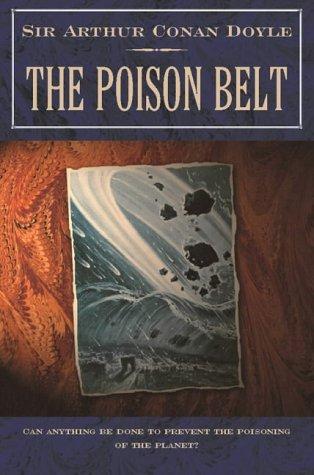
THE POISON BELT by Sir Arthur Conan Doyle
In 1898, H.G. Wells used the science fiction story... at the time, "scientific fantasy"... to spin an apocalyptic tale of invasion by Martians. Death and destruction on a scale beyond that of any terrestrial war was chronicled, and literary history was made. Twenty years later, the creator of Sherlock Holmes decided to turn his own hand to an extraterrestrial attack, with a slight difference: everybody dies.
Well, almost everybody. After the event, there are six people left alive. To those familiar with Doyle's earlier The Lost World, it should be no surprise that five of them are Professor Challenger and his wife, and Challenger's three companions from The Lost World: materialist Professor Summerlee, adventurer Lord John Roxton, and reporter Edward Malone. Apart from the one other survivor, all multicellular animal life on the Earth is killed.
Because of the story format, any thoughtful reader will recognize that at least a few others must survive through to the end, and in fact it develops that despite the death of all animals, they - in the words of a famous Monty Python movie scene - get better.
The Poison Belt was first published in 1919, before the science fiction boom and before the advent of the pulp hero. It is apparent that Doyle was, again, ahead of his time. This pre-genre title is ultimately an adventure story but dabbles at being science fiction and post-apocalyptic horror. The scientific theory upon which the story was based has long been disproven, but the story still works well enough in its chosen format and is as pleasantly readable as his more famous Holmes tales.
Three stars out of five.

RINGSTONES and Other Curious Tales by Sarban
Sarban's first book, from 1951, collects some short fiction and the title novella. The stories grow longer as the book progresses, and it violates a basic editorial rule: putting the strongest and second-strongest stories in the book at the beginning and the end. In this book, each story is better than the one before it, and it's easy to see why.
Sarban (John William Wall) had been a British diplomat and his experiences provided a realistic air to the foreign lands which served as settings for many of his works. He had a good eye for detail and he worked to provide images for the reader. By doing so, he would typically spend multiple pages developing the primary characters and locales. In shorter works, this results in half of the story being used to prepare the reader for the beginning of action.
While his short fiction does not completely fail, it is nevertheless unsatisfying. His lesser efforts are unimpressive, and his better ones feel like they were sent through a filter of 1800s fantasy literature. As the stories grow longer, the developmental aspects of his writing play better for the reader. When events happen to the characters, the reader cares. This is especially true in the title novella which takes nearly the final half of the book. It is a masterful thriller in which we see a trap being steadily woven around an unsuspecting, bright and genial woman whose single greatest vulnerability is a lack of familiarity with magic and legend.
This is the weakest of Sarban's original three books. If that sounds harsh, it's only because his other books were even more impressive.
Four stars out of five.

Doctor Rat by William Kotzwinkle
This novel from 1976 is IMPORTANT. The author obviously wants you to know this. And despite almost half of the book sounding like a story told by a self-loathing zoophile on mescaline, the author is completely successful.
The saccharine fantasy elements are needed here, as counterpoint to the sterile insanity of Doctor Rat and the animal testing lab where he lives. This is a testing lab like none other, but only because of the size and scope of the lab. The tests described by Kotzwinkle are representative of tests which were performed by scientists throughout the country, and they are grotesquely inhumane.
Exposure of just how violent and torturous most animal experimentation was has led to significant overhaul of animal testing. It's still a source of thousands of deaths per year of rats, mice, birds, rabbits, cats and dogs, but rules exist in most countries to minimize all unnecessary suffering. Efforts of people like Kotzwinkle are why.
There is gore here to fit nicely with the splatterpunk wave of the late 1980s, but it is all described clinically by the title character. The dispassionate recounting of horrors makes the story simultaneously more palatable to the reader and more haunting. Yet the Doctor's half of the story is not merely a recitation of nightmare after nightmare, it is a sendup of a political espionage thriller sporadically interrupted by the Doctor's ruminations on one test or another.
The book is important. It also manages to be funny and sickening simultaneously. It's excellent.
Five stars out of five.
--Bill Lindblad
